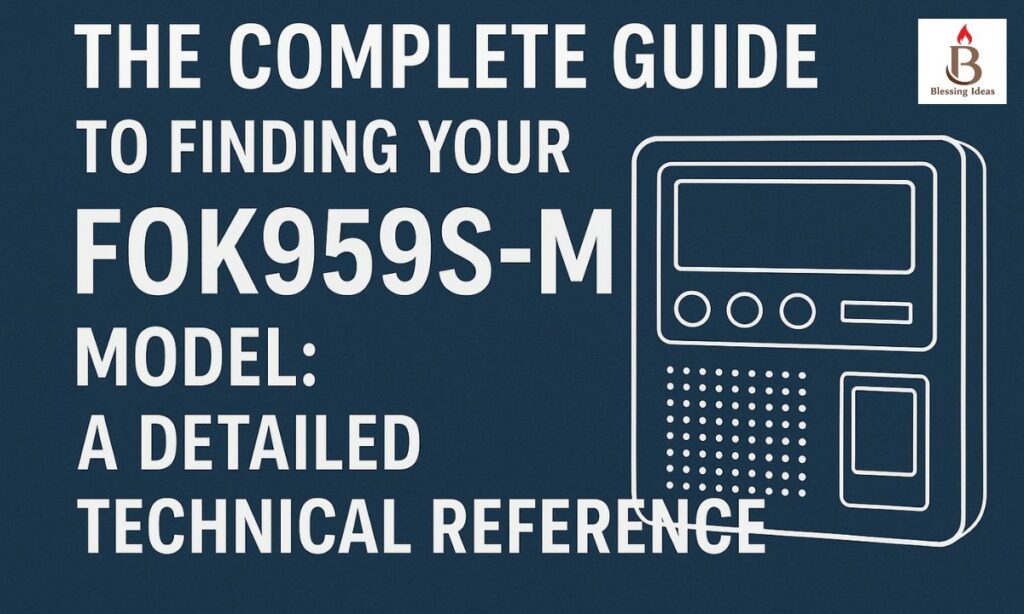Introduction
Finding your FOK959S-M model can feel overwhelming at first. Many people struggle to locate this specific identifier. The model number is not always visible or easy to access.
The FOK959S-M model is found in specialized equipment. It appears on circuit boards and technical components. Many people don’t know where to start looking. Others check the wrong locations first. This wastes valuable time and energy.
Understanding the identification process is essential. You need to know what you’re looking for. The model code looks like text or numbers. It may appear on stickers or labels. Sometimes it’s printed directly on circuit boards. Other times it appears in documentation. This guide covers all possible locations systematically.
What Is the FOK959S-M Model?
The FOK959S-M is a specific product identifier. It works like a serial number or part code. This model designation appears on specialized components. It’s not like common consumer electronics. Most people recognize brands like Sony or Samsung. The FOK959S-M is different from those household names. It’s typically used in industrial settings. Technical professionals use this model code regularly. Component manufacturers assign these codes. Original equipment makers use them too. The code helps identify exact specifications. It ensures compatibility between parts and systems.
Understanding what FOK959S-M represents is crucial. This model code contains important information. The letters indicate the manufacturer or product line. The numbers specify the exact model variant. The suffix provides additional details. Different versions may have different letters or numbers. Rev numbers indicate revision versions. These details matter when ordering replacement parts. A single number difference can mean incompatibility. Never assume two similar codes are the same. Always verify the exact model designation.
The FOK959S-M appears in several locations. You may find it on external labels or stickers. Internal circuit boards often display it. Packaging materials typically include this code. Warranty cards sometimes show it clearly. Service manuals list the model prominently. Online databases contain this information. Supplier catalogs feature this model code. Understanding these possible locations helps immensely.
Step 1: Physical Inspection
Physical inspection is your first and best resource. Start with what you can see directly. Look at the device carefully and methodically. Begin with external surfaces. Check the back of the component carefully. Look at the underside next. Examine side panels thoroughly. Most manufacturers place labels there. These labels contain crucial information. Stickers usually show model and serial numbers. Take your time during this inspection. Don’t rush through this important step.
Inspecting external surfaces requires attention to detail. Start from the top of the device. Work your way around systematically. Look for any printed text or numbers. Manufacturers place these labels strategically. They’re designed to be visible but unobtrusive. Labels may be small or large. Some are color-coded for easier identification. Stickers sometimes have holograms for authenticity. Take clear photographs of any codes you find. These photos serve as backup records. They help when you contact support later.
Check internal parts if it’s safe to do so. Open the device carefully if possible. Examine all circuit boards inside. Printed circuit boards often display model codes. The code appears directly on the board. It’s usually printed in clear, bold text. Sometimes it’s in a corner or edge. Other times it’s centrally located. Board markings rarely fade or wear away. They provide reliable information sources.
Review packaging and manuals carefully. The original box often contains model information. Installation guides list specifications clearly. Service booklets include model codes. Warranty cards frequently show this data. Keep these original materials safe. They’re valuable reference documents. Photograph identifiers for future reference. This creates a permanent digital record. You won’t need to reopen the device later. These photos prove ownership and specifications. They help during troubleshooting situations. Store them in cloud storage for safety.
| Location | Likelihood | Details |
| External Labels | Very High | Front or back sticker with model code |
| Internal Boards | High | Printed directly on circuit board |
| Packaging | High | Original box contains information |
| Manuals | High | Service books list model designation |
| Warranty Cards | Medium | Product registration documents |
Step 2: System or Software Diagnostics

Electronic systems often contain built-in diagnostics. These tools reveal hidden information. Many devices display model numbers automatically. System settings provide hardware details. You don’t need to open anything. The information is already stored internally. Software can access this data easily. Computers display model information in system settings. Check the “About” section in menu options. This shows hardware specifications clearly. Different operating systems organize this differently.
Firmware tools provided by manufacturers are extremely helpful. These specialized programs access hardware identifiers. They work without physical openings required. Download the tool from the manufacturer’s website. Install it on your system carefully. Run the diagnostic scan next. The tool identifies all hardware components. Model numbers appear in the results clearly. Save these results to a file. They provide official documentation. Manufacturers recognize these reports as valid proof.
Startup screens sometimes show model information. Watch your device boot up carefully. Important data appears during startup sequence. The bootloader displays hardware details often. BIOS screens reveal system information. Photograph or record this information. It appears only during startup. You won’t see it during normal operation. Write down everything you see. This startup data is highly reliable. Manufacturers program this information specifically for identification purposes.
System diagnostics save time and energy. You avoid physically opening devices. The process is completely non-destructive. No risk of damaging components exists. Results are accurate and official. The system itself confirms the model. This is stronger evidence than physical inspection. Hardware manufacturers validate this data. Support teams trust these results completely.
Step 3: Manufacturer and OEM Resources
Manufacturers are your best information source. They created the FOK959S-M model. They maintain official documentation extensively. Contact them directly with your questions. They have specialized support teams. These teams know the model inside out. They answer questions accurately and completely. Provide them with your model code. Include any additional details you have. They verify information quickly and efficiently.
Official product catalogs contain comprehensive information. These catalogs list all model variants. Specifications appear in detail clearly. Images show what the component looks like. Diagrams illustrate connections and layouts. Pricing information is sometimes included. These catalogs are regularly updated. They remain accurate and current. Download these catalogs from manufacturer websites. They’re usually free to access. Store digital copies for future reference.
Archived data sheets provide technical specifications. These documents are extremely detailed. Pin layouts appear clearly in diagrams. Voltage requirements are specified precisely. Compatibility information is clearly stated. Features are listed comprehensively. Performance specifications are documented thoroughly. Electrical characteristics are detailed extensively. These documents are highly technical. They’re essential for professionals and experts. Regular users can understand the basics. Download these sheets directly from manufacturers. They contain crucial reference information.
Service or parts lookup portals are incredibly useful. Enter your model code to find information. These portals search extensive databases. Results show available parts immediately. Prices and availability appear clearly. Compatibility information is verified. Parts diagrams help identify components. Assembly instructions are sometimes available. These portals are completely free to use. They’re updated regularly by manufacturers. Bookmark these portals for future use.
Authorized dealer inventories provide current stock information. These dealers work directly with manufacturers. They have access to official resources. Their information is always accurate. They can order parts directly for you. They know compatibility requirements thoroughly. They provide professional recommendations. They understand the FOK959S-M model completely. Contact local authorized dealers in your area.
Step 4: Smart Search Techniques
Searching for the FOK959S-M requires precision. Use quotes around the exact model number. Type “FOK959S-M” in quotation marks. This forces search engines to find exact matches. You avoid getting similar but wrong results. This saves considerable search time. Irrelevant pages are filtered out automatically. Only highly relevant results appear first.
Adding context words improves search results significantly. Include technical terms related to your device. Try words like “board” or “module” for components. Add “datasheet” to find technical documents. Include “manual” to find user guides. Try “specification” for detailed technical information. Context words guide search engines toward relevant pages. Results become more targeted and useful. You waste less time on irrelevant pages.
Include extra identifiers in your searches. Add revision numbers if you have them. Try “FOK959S-M Rev 2.0” as a search term. Include batch codes if visible on your device. Add serial number fragments if available. These specifics narrow searches dramatically. You find exact information quickly. Multiple search combinations yield better results overall.
Try variant spellings in your searches. Component codes sometimes appear with spaces. Try “FOK 959S M” as an alternative. Try “FOK959SM” without the hyphen. Try “FOK-959S-M” with different punctuation. Different websites format codes differently. Trying variants ensures you find all available information. You won’t miss important pages because of formatting differences.
Use reverse image search if you have photos. Upload your component photo to Google Images. The search engine finds similar images online. This matches your component visually. You find exact matches more easily. Other variations appear in results. This method works excellently for components. You confirm your model visually. Accuracy is extremely high with visual matching.
Step 5: Cross-Validation
Never rely on a single source alone. Always confirm your findings with multiple sources. Compare images online with your actual device. Look at colors and markings closely. Check if dimensions appear similar. Note any differences you observe. Identical images mean you’ve found the right model. Conflicting information requires further investigation.
Checking specifications is absolutely essential. Review technical specifications from multiple sources. Compare voltage requirements with other sources. Pin layout diagrams should match perfectly. Size measurements must be consistent. Performance specifications should remain the same. Differences indicate you’re looking at wrong information. Identical specifications confirm your findings.
Verify variant codes very carefully. Different revisions have different capabilities. Rev 2.0 may not work where Rev 3.1 is required. Always match your exact revision number. Check compatibility matrices thoroughly. These show which revisions work together. Never assume revisions are interchangeable. Installation may fail with wrong revision. Performance may be degraded or incompatible.
Contact suppliers or manufacturers with your findings. Send them your research results. Include photos you’ve collected. Ask them to confirm your identification. Provide your serial number for verification. They access their databases directly. They give you definitive answers. Their confirmation is highly authoritative. This final step removes all doubt. You proceed with complete confidence.
Step 6: Supplier and Marketplace Checks
Supplier catalogs often list obscure models first. These specialized suppliers stock technical components. They maintain extensive inventory records. Their databases are very comprehensive. Search their catalogs specifically. Results show availability and pricing. Many obscure models appear here first. Mainstream retailers may not stock them. Specialized suppliers are your best resource.
Checking photos closely against your component is vital. Zoom in on the images provided. Look for matching text and numbers. Colors should match your device. Physical appearance should be identical. Logo placement should be the same. Any differences mean it’s a different model. Match every visible detail carefully. This prevents ordering wrong parts.
Reading specifications carefully protects against mistakes. Compare all listed specifications to yours. Electrical characteristics must match exactly. Connector types should be identical. Pin configurations must match perfectly. Dimensions need to be exact. Performance specifications require careful comparison. A single mismatched specification means incompatibility. Never overlook small details.
Asking sellers for additional data is always wise. Email them with your questions. Provide photos and specific questions. Ask about compatibility with your system. Request documentation if available. Ask about warranty information. Request return policies clearly. Professional sellers provide detailed responses. Their answers help confirm your choice. Reliable sellers want satisfied customers.
Watching for mistyped model codes is important. Sellers sometimes list codes incorrectly. Similar-looking codes are easy to confuse. Verify the exact spelling carefully. Check each letter and number. Reversed digits are common mistakes. Confused letters sometimes appear in listings. Verify everything before purchasing. Contact the seller if anything looks wrong. Confirmation prevents costly mistakes.
| Step | Action | Importance |
| Photo Verification | Compare images carefully | Critical |
| Spec Checking | Match all specifications | Critical |
| Seller Contact | Ask for clarification | Important |
| Code Verification | Confirm exact spelling | Critical |
| Documentation | Request available docs | Important |
Step 7: Documentation
Once you’ve confirmed the FOK959S-M model, create complete records. Documentation saves time during future repairs. You won’t repeat this research process again. Record the full model designation accurately. Include any revision numbers. Note the serial number. Include the date of verification. Store this information securely.
Save any specification sheets you find. Download datasheets directly from manufacturers. Store them in cloud storage for safety. Organize files by model number. Create a backup copy locally. These documents are invaluable references. You need them during troubleshooting. They help when ordering replacement parts. Keep them organized and easily accessible.
Keep clear photos of your device and its markings. Take photos from multiple angles. Capture all visible text clearly. Include photos of internal components. Save photos in high resolution. Store them with associated information. Label each photo with the date. These visual records prove ownership. They confirm specifications. They’re valuable if you need support assistance.
Store your findings for future repairs or replacements. Create a dedicated folder for this model. Include all research materials there. Add part numbers you’ve identified. Include supplier contact information. Note any compatible parts you’ve found. Record any known issues or quirks. This becomes a personal reference database. Future maintenance becomes much faster. You have all information immediately available.
Troubleshooting Common Problems

No results at all during searching requires persistence. Try alternate spellings systematically. Add technical keywords specific to your device. Search for component manufacturers. Try searching part numbers backwards. Search for the component functionality instead. Try searching in different languages. Ask on technical forums for assistance. Post your photos on community websites. Experienced users often help identify obscure components.
Conflicting sources between different websites requires careful analysis. Rely on images and specifications as tiebreakers. Manufacturers provide the most authoritative information. Official sources are always most reliable. When in doubt, contact manufacturers directly. Their verification is definitive. Don’t make decisions based on conflicting information.
Worn labels that are illegible need creative solutions. Use reverse image search with your photos. Search for similar looking components online. Use board layouts to identify components. Check manufacturing date codes if visible. Contact manufacturers with your serial number. They can often identify components from dates. Look for any remaining visible markings. Small details can unlock identification
.
Obsolete models require extended searching. Try niche forums dedicated to this technology. Ask in specialty user communities online. Contact vintage component suppliers. Search auction sites for similar models. Retired engineers sometimes help with identification. Technical schools may have reference materials. Patience and persistence eventually succeed.
Multiple revisions require exact matching. Always match your revision number specifically. Different revisions may be incompatible. Cross-reference revision specifications carefully. Verify all revision details before purchasing. Revision information is listed on labels. Note the exact revision you own. This prevents costly compatibility mistakes.
Example Case
Imagine you own a controller with marking “FOK959S-M Rev 2.1” clearly visible. Here’s exactly how you’d confirm it properly. First, inspect the device carefully. Note the revision code exactly as shown. Write down all information visible. Take clear photographs of all markings. This documentation is your starting point.
Next, search for “FOK959S-M Rev 2.1” using quotation marks. This exact search filters results precisely. Only pages mentioning this specific revision appear. You avoid wading through irrelevant results. Results should be highly targeted. Review the top results carefully. Note any manufacturer information appearing. Save any official datasheets you find.
Then compare images online with your component carefully. Look at colors, markings, and dimensions. Check if boards look identical. Verify any logos or text matches. Physical appearance should match exactly. Identical images confirm your model identification. Note any suppliers carrying this specific revision.
Check the specifications against your device’s behavior. Review electrical specifications. Compare how your device functions. Performance should match documented specs. Any discrepancies indicate problems. Specifications should perfectly align with observations. This verification step is very important.
Contact a supplier for official confirmation next. Provide your research findings. Send clear photos of your component. Ask them to verify your identification. Request pricing for replacement parts. Ask about availability and warranty. Professional confirmation removes all doubt. Document their response in writing.
Document your findings completely before ordering parts. Save all research materials. Create a folder containing everything. Include photos, specifications, communications. Back up all information to cloud storage. This preparation prevents future problems. You have everything documented. Future reference is quick and easy.
Conclusion
Identifying the FOK959S-M model is entirely manageable. It may feel like detective work initially. The right steps make it simple. Always begin with physical inspection first. Labels, stickers, and board markings provide reliable information. They rarely lie or mislead. Next, check system diagnostics if available. These reveal hidden information easily. Use smart search techniques to find results. Precision in searching saves tremendous time. Manufacturer resources and supplier catalogs provide additional validation.
Cross-validate every piece of information carefully. Never trust single sources alone. Images and specifications break ties effectively. Revision codes are absolutely critical. Ensure compatibility before making purchases. Once confirmed, document your findings thoroughly. Notes help you remember details later. Photos provide visual confirmation. Specifications ensure future compatibility. Saved datasheets become reference materials.
Frequently Asked Questions
What is the FOK959S-M model?
It’s a specialized product identifier used for industrial components, circuit boards, and technical modules rather than mainstream consumer electronics.
Why is the FOK959S-M model hard to find online?
Because it’s niche and industrial, documentation is less widespread than consumer products, requiring precise search methods and specialized resources.
Can variants like FOK959S-M Rev 2.0 replace the base model?
Only if all specifications match exactly, so always verify revision numbers and compatibility before using substitutes.
What if the model label is missing or worn?
Use internal board markings, connector layouts, board layouts, or reverse image searches to identify the component.
How do I confirm I’ve found the correct FOK959S-M model?
Cross-check images carefully, compare all specifications, review revision codes, and confirm with suppliers or manufacturers before proceeding.






